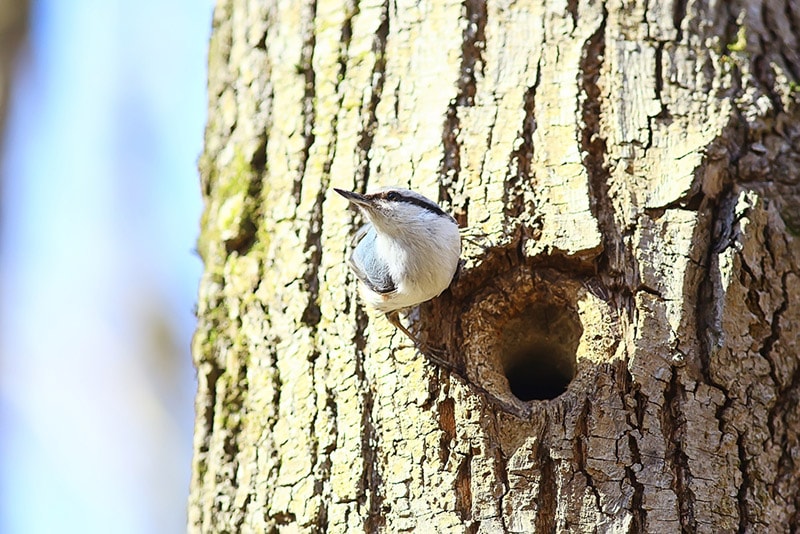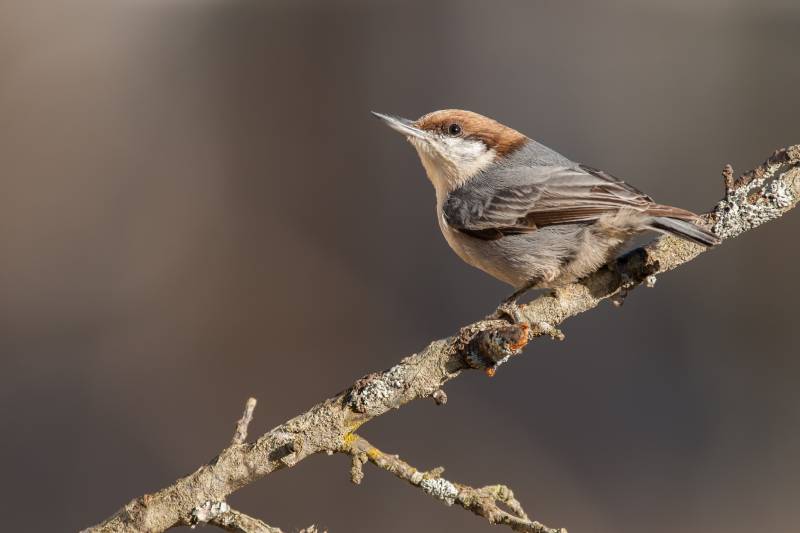Where Do Nuthatches Nest? Nuthatch Nesting Habits Explained
Last Updated on

The white-breasted nuthatch is an attractive bird that is common throughout the United States all year. However, its small size can make it hard to spot, so many people wonder about its nesting habits, as these can provide clues about where you can find them and their preferred habitats. The common white-breasted nuthatch likes to make its nest in a cavity or hole that it finds in a tall tree.
If you’ve been looking to spot these birds, keep reading as we describe their nesting habits and where they like to spend their time so you will have a better chance of locating one in the wild.

What Are the Nesting Habits of the Nuthatch?
The nuthatch prefers to make its nest in a tall tree, often in a hole dug by a woodpecker, but it will select any hollow area if none are available. You might even convince one to use a nest box if you don’t have many trees around your home and the nuthatch is low on options.

Nest Description
Once selected, the female will build the nest on her own. She will line the cavity with fur, dirt, and bark to create a warm stable base. She will then create a nest from grass feathers, shredded bark, and other soft materials. If possible, she will reuse the nest for several years.
Nesting Facts
The female nuthatch will usually lay four to six eggs at a time and then incubate them for up to 16 days before they hatch. The male will typically leave the female to do most of the work, but he may provide food for the chicks after they hatch.
When Do Nuthatches Build a Nest?
The date of nest building can vary by climate, though you usually see them building a nest between May and June. If you’re lucky enough to find a nest on your property, you will likely see them again next year when they return.

Are Nuthatches Aggressive?
Nuthatches are not aggressive, but they are territorial during the breeding season. They will defend their nest from other birds if they feel threatened and will also engage in behavior to drive away unwanted guests, including humans.
Is the Nuthatch a Woodpecker?
No. You will often see nuthatches in the same area as woodpeckers because they eat the same kind of food and nuthatches like to use woodpecker holes as nests, but they’re not the same kind of bird and don’t associate with each other much.
Why Do Nuthatches Eat Upside Down?
One of the reasons that bird watchers seek out these small birds is because they have strange eating habits. It uses its sharp claws and mobile toes to climb headfirst down a tree looking for insects, which can lead many people to worry that it will fall.

How Can I Attract Nuthatches to My Property?
The best way to attract nuthatches to your property is to install a bird feeder that contains plenty of sunflower seeds, peanuts, and mixed nuts. These birds also love suet and often peck at it without stopping.
How Can I Tell the Male Nuthatch From the Female?
Both sexes of nuthatch have similar colors and patterns, but the male will have darker tones, helping it to stand out.

Summary
The common white-breasted nuthatch likes to make its nest in a cavity or hole that it finds in a tall tree. It will use a woodpecker hole if it can find one, even if it is too large, and it will use the same nest year after year if it can. These birds are common visitors to backyard bird feeders, especially if you have black sunflower seeds or peanuts, but they don’t usually use nesting houses unless they’re desperate.
Featured Image Credit By: Kichigin, Shutterstock
Table of Contents
About the Author Ed Malaker
Ed Malaker is a veteran writer who contributes to a wide range of blogs covering information on computer programming, pets, birding, tools, fitness, guitars, and optics. Outside of writing, Ed is often found working in the garden or performing DIY projects in the house. Ed is also a musician, spending his time composing music for independent films or helping people repair their guitars.
Related Articles:
10 Types of Hummingbirds in Arkansas (With Pictures)
8 Types of Hummingbirds in Nebraska (With Pictures)
5 Types of Hummingbirds in Idaho (With Pictures)
3 Types of Hummingbirds in Mississippi (With Pictures)
8 Types of Hummingbirds in Kansas (With Pictures)
5 Types of Hummingbirds in West Virginia (With Pictures)
5 Types of Hummingbirds in Ohio (With Pictures)
Why Do Some Birds Lay Their Eggs in Other Bird’s Nests? The Interesting Answer!
